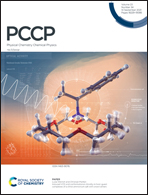Two-dimensional metallic carbon allotrope with multiple rings for ion batteries
Abstract
Two-dimensional (2-D) materials, especially carbon allotropes, have larger storage capacity and faster diffusion rate due to their unique structures and are usually used in ion batteries. Recently, a new stable two-dimensional carbon allotrope, namely PAI-graphene, was reported by first-principles calculations. Due to its lightweight and multiple-ring structure, great stability and excellent properties, here, we theoretically reveal the excellent performance of PAI-graphene as an anode material for Li-/Na-ion batteries. Our results show that PAI-graphene has intrinsic metallicity before and after adsorption of Li/Na, which ensures that it has good conductivity when working as an electrode material. In addition, PAI-graphene exhibits quite low open circuit voltage (0.342–0.190 V for Li, 0.339–0.233 V for Na) and diffusion barrier (0.34 eV for Li, 0.17 eV for Na), which indicates its superiority as an anode material. Most noteworthily, the Na storage capacity of PAI-graphene is up to 1674 mA h g−1, which is much higher than that of most 2-D anode materials. Thus, we believe that PAI-graphene can be an outstanding anode material with outstanding performance.



 Please wait while we load your content...
Please wait while we load your content...